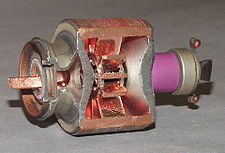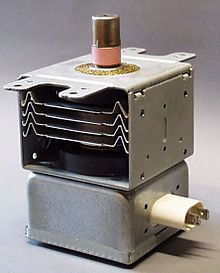Cavity magnetron
The cavity magnetron is a high-powered vacuum tube that makes microwaves using the interaction of a stream of electrons with a magnetic field. Electrons pass by holes (cavities), and the resonance creates microwaves, like blowing air on a flute creates sound (sound waves) of a certain pitch.[1] The 'resonant' cavity magnetron type of the earlier magnetron tube was invented by John Randall and Harry Boot in 1940.[2] The high power of pulses from the cavity magnetron made centimetre-band radar practical. Shorter wavelength radars allowed the finding of smaller objects. The small cavity magnetron tube made the size of radar sets much smaller[3] so that they could be put into in aircraft[4] and ships used to find submarines.[3] At present, cavity magnetrons are commonly used in microwave ovens and in various radar applications.[5]


References change
- ↑ "How do magnetrons work?". Explain that Stuff. 28 August 2009. Retrieved 2020-05-20.
- ↑ "The Magnetron". Bournemouth University. 1995–2009. Retrieved 23 August 2009.
- ↑ 3.0 3.1 Schroter, B. (Spring 2008). "How important was Tizard's Box of Tricks?" (PDF). Imperial Engineer. 8: 10. Archived from the original (PDF) on 2011-06-17. Retrieved 2009-08-23.
- ↑ "Who Was Alan Dower Blumlein?". Dora Media Productions. 1999–2007. Archived from the original on 7 September 2009. Retrieved 23 August 2009.
- ↑ Ma, L. "3D Computer Modeling of Magnetrons Archived 2008-10-10 at the Wayback Machine." University of London Ph.D. Thesis. December 2004. Accessed 2009-08-23.